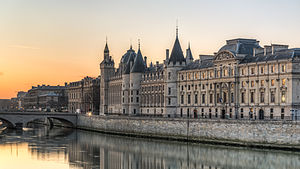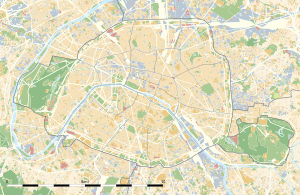Île de la Cité
| Île de la Cité | ||
|---|---|---|
| Hôtel-Dieu , Tribunal de Commerce, Conciergerie and Court of Cassation on the Quai de l'Horloge | ||
| Waters | His | |
| Geographical location | 48 ° 51 '18 " N , 2 ° 20' 48" E | |
|
|
||
| length | 1.19 km | |
| width | 290 m | |
| surface | 22 ha | |
| Residents | 981 (2013) 4,459 inhabitants / km² |
|
| Aerial view of the Île de la Cité from the north-west | ||




The Île de la Cité ([ il də la site ], "city island") is an inland island in the Seine and the oldest part of the French capital Paris . Over the centuries it increased from 8 to 22 hectares and is connected by nine bridges to the two banks of the Seine, Rive Droite and Rive Gauche, as well as to the neighboring island of Île Saint-Louis . In a clockwise direction and starting from the west, these have the following names: Pont Neuf , Pont au Change , Pont Notre-Dame , Pont d'Arcole , Pont Saint-Louis , Pont de l'Archeveché , Pont au Double , Petit Pont and Pont Saint -Michel .
The Boulevard du Palais divides the island into two parts belonging to different arrondissements ; the western part belongs to the 1st , the eastern part to the 4th arrondissement of Paris .
The Île de la Cité is the location of the Notre-Dame de Paris , the seat of the Archbishop of Paris , the former royal residence Palais de la Cité (today the Palace of Justice ) with the former palace chapel Sainte-Chapelle and the conciergerie as well as the prefecture of the police .
history
The Île de la Cité was already settled in antiquity - first by the Celts and later (after 52 BC) as a city of the Roman Empire in Gaul . When Clovis I of the Merovingian family made Paris the capital of his empire in the early 6th century, the Île de la Cité was once again the focus. Around 540/550, under the reign of the Frankish King Childebert I (King from 511 to 558), the St. Etienne Cathedral (Stefansdom), which was the predecessor of the Notre-Dame de Paris Cathedral , was built. The Grand Master of the Templar Order Jacques de Molay was executed on the western tip in 1314 .
The connection to the banks of the Seine is made by the “New Bridge” ( Pont Neuf ), the oldest preserved bridge in Paris. When they were built (1578–1607), Heinrich III. the three marshy alluvial islands that were located off the western tip of the Île de la Cité, connected to it in 1584. On the newly acquired area of the Cité, he had a square built (today's Place Dauphine ) and houses, from whose sale he raised the money needed to build the bridge.
Attractions
Worth seeing on the Île de la Cité
- the Notre-Dame cathedral
- the former royal residence Palais de la Cité (now the Palace of Justice)
- the former palace chapel Sainte-Chapelle
- the conciergerie
- one of the royal squares, the Place Dauphine
- the Mémorial de la Déportation
- the flower market (bird market on Sundays)
Future planning
As part of the Mission Île de la Cité project, the area is to be reoriented in terms of urban planning by 2040 under the leadership of the architect Dominique Perrault. The cultural attractions are to be brought more into focus; the quarter is to be revitalized with shops and apartments; Visual connections to archaeological remains are to be created.
More pictures
Individual evidence
- ↑ Maison d'étude Île de la Cité. Retrieved October 3, 2017 .
Web links
- Image of the Île de la Cité in 1540
- Île de la Cité - Images from today and the early 20th century







